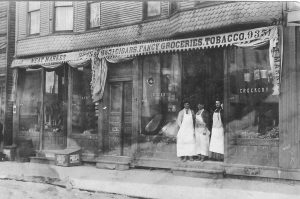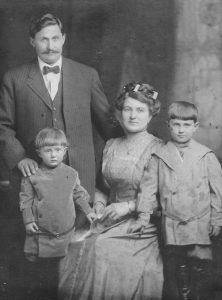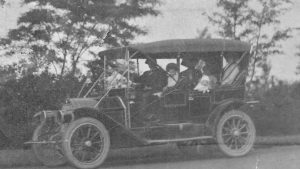Note to readers: This exploration of my family history is primarily for my kids and kinfolk. I’m posting it in my blog because I’m too cheap to set up a separate website. If you are not among my relatives you probably won’t be interested in this stuff, and that’s fine with me.
In the 1890s the newest immigrants to arrive in Chicago – Hungarians, Italians, Ukrainians and Poles — settled on the Southeast Side because that’s where the factories were. Thousands were employed at the Illinois Central Railroad repair shops, the Pullman Car Works and others. The neighborhood where they lived was called Burnside because a nearby railroad station was named for a Civil War general.
They made good money and worked up an appetite, those factory guys, and some of their groceries came from my grandfather. Joseph (Jozsef) Hajdu Gasperik trained in Hungary as a butcher and sausage maker, and arrived in Chicago around the turn of the century.
His shop was at 9349-51 S. Cottage Grove Avenue. He arrived in the U.S. in 1903 and married my grandmother, Julia Nemeth, in 1904. The family lived over the store. My mother, Vilma, youngest of three children, was born in 1916.
The family prospered: My grandfather owned rental property and an automobile. They spoke Hungarian at home, and my mother did not learn English until she started school. Although most Hungarians were Catholic, the Gasperiks attended a Hungarian Reformed church. (My mother told me she was christened Wilhelmina because the minister did not believe Vilma was a proper Hungarian name.)
The Hungarian community in Chicago stayed fairly small: not for lack of immigrants, but because Hungarians assimilated quickly and were more inclined to intermarry with other ethnic groups than did the Italians, Poles and Lithuanians. So the Hungarian community in Burnside that thrived in my mother’s childhood is largely a memory today.
My mother’s oldest brother, Joe, was 13 years older. She was closest to her brother Frank, who was seven years older but died when he was 18. There were relatives nearby, Gasperik and Nemeth cousins whose families had migrated to Chicago.
And there was drama: My grandparents divorced at some point and my grandmother remarried in 1935. Her second husband, John Kristof, died three years later. The store on Cottage Grove Avenue was a casualty of the Depression, and brother Joe married and moved to California. My mother graduated from Fenger High School.




2 Responses to Family stories: Burnside